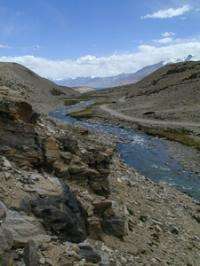New information about how Himalayas were formed

Evidence of the mineral majorite in Himalayan rocks have overturned scientific theory about the birth of the tallest mountains on Earth.
Geologists have long debated aspects of the collision between Asian and Indian landmasses that formed the Himalayas about 57 million years ago. When the continents collided they closed an ocean between them. The Asian plate forced the Indian plate, still connected to the denser ocean crust, down toward the Earth's mantle in a process called subduction.
Assistant Professor of Geosciences Mary Leech was part of a team of researchers who examined the content of metamorphic rocks that were caught up in the collision between the Asian and Indian landmasses. They examined thin sections of rocks known as eclogites. Collected in the Ladakh region of northwest India near Tibet at an altitude of about 15,000 feet, these samples contained garnet. The garnets held chemical evidence of majorite, which is formed only under extreme pressure at depths of 185 to 200 kilometers. This is more than twice the distance previously accepted (90 kilometers) regarding the depth the Indian crust sank during the continental collision.
"This is the first evidence of the mineral majorite in eclogite rocks found in the Himalayas," Leech said. "Current computer models do not indicate that rocks like those we examined got to such depths and came back up to the surface."
Eclogites are metamorphic rocks formed in subduction zone complexes in mountain belts where two continents come together. Minerals found in the eclogites and formed by extreme pressure give geologists clues to the movement and history of mountain formation. As mountains continue to develop over millions of years, the eclogites move back up to the surface where geologists can easily access samples.
Leech said that the findings will radically change scientific models regarding the age of the mountains and the rate and angle at which the Indian plate continues to collide with the Asian plate while forcing up the Himalayas.
The study, titled "Evidence of former majoritic garnet in Himalayan eclogite points to 200-km-deep subduction of Indian continental crust," was published in the May 2010 issue of the journal Geology. Principal investigator of the study was Anju Pandey of the National Oceanography Centre in Southampton, England.
Leech, a recipient of the prestigious National Science Foundation CAREER grant, studies the chemical aspects of mountain formation and has conducted field work in Himalayan mountain belts as well the Dabie-Sulu belt in eastern China, the Scandinavian Caledonides of Norway, the Urals in Russia and the Kokchetav Massif in Kazakhstan. Her research focuses on eclogite found in these mountain belts.
More information: geology.gsapubs.org/content/38/5.toc
Provided by San Francisco State University

















